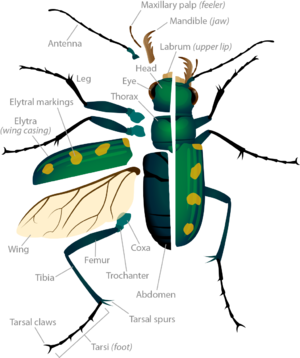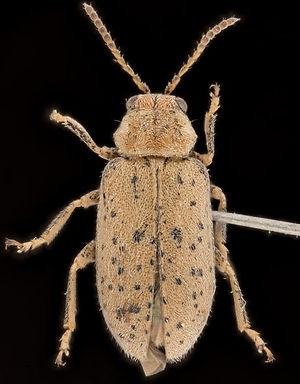Coleoptera
Coleoptera, known as beetles, are a diverse taxonomic order that includes over 350,000 species; this makes it the largest order in the animal kingdom. Coleoptera can be found on all continents except Antarctica, being most diverse in tropical zones where water and nutrients are abundant. They are of the kindom Animalia, the phylum Anthropoda, subphylum Hexapoda, and the class of Insecta. Almost all beetles undergo complete metamorphism, which, in addition to the elytron, are their most distinctive features. With a high variety of species, habitats, and diets, beetles can be found virtually anywhere on Earth. "[TOC]"
Characteristics

Coleoptera are a highly diverse order, all of which go through complete metamorphosis. This describes the process of undergoing four life-stages. These include the egg or embryo, the larva, the pupa, which is the resting or transformative stage, and finally imago, which is the adult or sexual stage. Animals that undergo complete metamorphism are called holometabolous.
The anatomy of beetles is very similar to other arthropods, consisting of a head, thorax and abdomen, however these segments are differentiated and help to classify beetles. Unlike other arthropods, coleopteras have their mesothorax and metathorax attached to the abdomen. The third segment, prothorax, is isolated between the head and lower body, and is covered by a dorsal plate called the pronotum.
The head consists of simple single-lens eyes, which are very sensitive to movement. Their antennae serve to establish their surroundings and find food. They can touch, hear, taste, smell, feel temperature, and determine humidity. Strong mandibles serve as their jaw to breakdown food, and for some species they are used to fight off or intimidate predators or competition. Their head also holds their brain and mandibular muscles.
The thorax of the beetle is made up of the abdomen, elytra, hind wings, and six legs. The segmented legs are dedicated primarily to easy and rapid locomotion, but also facilitate in grooming, traction, and sometimes protection. Based on the species, the legs can be specialized for running, swimming, jumping, or digging. One of coleoptera’s most distinguishing features is their elytron. Elytra are the hardened forewings, and are the reason for their formal name. Koleos means sheath, and pteron means wing. These wings meet down a line down the middle of their backs and work in conjuction with their exoskeleton to protect their hind wings and their abdomen. These wings extend outward at 90 degree angles when in flight, revealing the membranous hind wings. Elytras vary in color for camouflage, reflecting heat, or warnings to predators.
The abdomen of beetles is comprised of nine or ten segments and contains their organs for digestion, breathing, and reproduction. On some beetles, such as the tiger beetle, the abdomen hosts ears to hear predators, such as bats. Coleoptera have an open circulatory system, meaning they do not have veins or arteries. Tiny pumps inside the beetle send hemolymph (blood of invertebrates) throughout the segmented body. The hemolymph transports nutrients and waste, however it does not aid in oxygen uptake.
Diet

One of coleoptera’s most distinguishing features is their elytron. Elytra are the hardened forewings, and are the reason for their formal name. Koleos means sheath, and pteron means wing. These wings meet down a line down the middle of their backs and work in conjunction with their exoskeleton to protect their hind wings and their abdomen. It is evident that due to the vast range of species and habitats, beetles’ diets vary just as widely.
Habitat
Coleoptera habituate all terrestrial and fresh-water environments, and are most abundant in the tropical regions of the lower latitudes. Depending on the species, beetles live on fungi, burrow into plants, and dig tunnels into wood or trees.